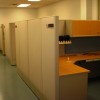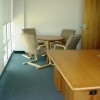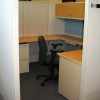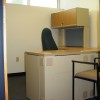Case Goods
Video
alt="" Corner Desk and HutchCase goods are interior office furniture made from hard materials that are not upholstered. Furniture has been a functional part of people's daily lives since sedentism; the development of communities led to defining furniture as a decorative art based upon local cultural influence. Furniture, over time, transformed from stacked stones in a shelter to ergonomically designed, manufactured furniture made out of metal, wood and plastic. Present-day interior office furniture comes in many different styles, which have been influenced over time by various cultures. There are also a variety of furniture types, developed for varying end-uses. This has resulted in an endless number of options when selecting interior office furniture.
Case goods include a variety of desk types, such as executive, reception, computer, credenza, L-shaped, and U-shaped. Desks serve as storage and as work surfaces for writing, computing, or collaborating. They can have legs or pedestals and are quite often matched with a credenza, bookcase or storage unit in a front to back orientation. Case goods also include various table types, such as boardroom, multi-purpose, workspace and side tables. They serve as surfaces used for meetings, project work, training, collaboration, dining, general purpose and decor.
These products are constructed with a variety of materials, sometimes used in conjunction with one another to define the case good's form and function. Materials can generally be categorized as metal, wood and plastic, but may also include glass and other hard materials. Metals used in case goods are strong, durable, and fireproof; they include steel, aluminum, brass, bronze, magnesium, casting alloys, and cast iron. Woods can be either hardwood or softwood, and be painted or stained. When stained, a solid wood desk has a certain richness to the wood grain texture. A variety of wood products are used in case goods, including solid wood, plywood with finish veneers, and substrate core materials with wood veneers. Similar to countertops, case goods can also have a substrate core that is clad with high density laminated plastic or pressed thermofoil. These products offer a wide selection of colors with visible texture. Glass used in case goods can be clear, colored, etched, obscure, textured or smoked.
When buying case goods, priorities should be set prior to beginning shopping. Things to consider include: an understanding of budget limitations, office space constraints, desired room layout, style, scheme and finish. Practical decisions are necessary to define the needs of an office space and should relate to the intended function, storage, and security required. Case goods can be purchased from a variety of locations, either assembled or ready to assemble. New furniture may be available through manufacturers or purchased at retail stores. Used furniture can be found in any number of ways; at times corporations will sell their old furniture, or used items can be found at auctions. Wholesale vendors offer new, used and refurbished office furniture. Vendors may sell from physical locations or online stores.

Buildipedia Staff
The Buildipedia research and writing staff consists of dozens of experienced professionals from many sectors of the industry, including architects, designers, contractors, and engineers.
Website: buildipedia.com/





